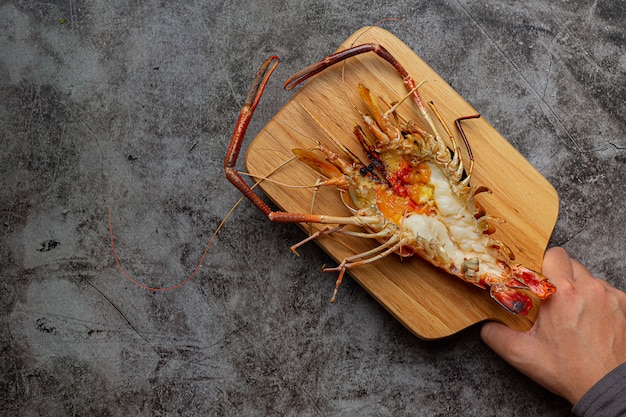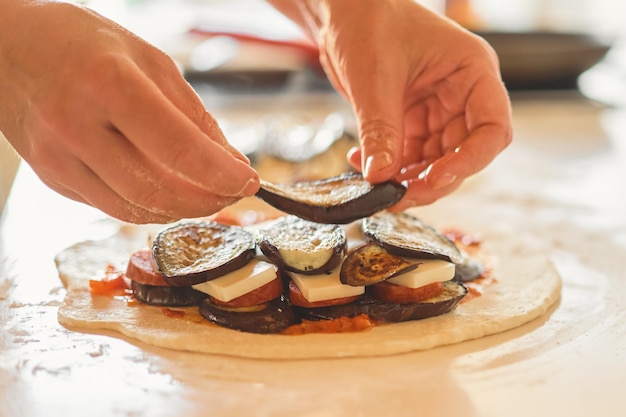You’ve got a live crab in your hands, and you're ready to cook up a delicious meal. But before you dive into the kitchen, let’s take a moment to understand the art of cooking crab. This isn't just about throwing it in a pot and calling it a day. It's about understanding the crab itself, appreciating its journey, and making sure you're doing it right, both for your taste buds and for the environment.
(Part 1)
Choosing Your Crab

First things first, you need a good crab. Not just any crab will do – we're after a prime specimen! I'm partial to brown crabs myself. They're just bursting with flavour! But whatever your preference, you're looking for a crab that's got a good weight to it, a firm shell, and lively little legs. Think of it as choosing the best ingredients for any dish - you want to start with quality.
Spotting a Good Crab
Here are some key things to look for when choosing your crab:
- Weight: A good crab will feel heavy for its size. This indicates that it's full of meat.
- Shell: The shell should be firm and free of any cracks or damage. A damaged shell might indicate the crab isn’t as fresh, or that it's been mishandled.
- Liveliness: The crab should be active and moving its legs. If the crab is sluggish or unresponsive, it's likely not fresh.
Where to Buy
If you're buying from a fishmonger, don't be afraid to ask questions. They're the experts! They'll be able to guide you towards the best crabs for your needs and tell you about their origin and sustainability practices.
Preparing the Crab

Alright, you've got your crab, now it’s time to get it ready for cooking. It's not exactly rocket science, but a little prep goes a long way.
Cleaning
First things first, you'll want to give your crab a good scrub with a stiff brush, especially under the shell. Get rid of any grit or sand that might be clinging to it. Don't be shy!
Removing the Legs
Now, for the legs. You'll need to give them a good twist and pull. They should come right off with a little bit of force. Don’t worry, it's easier than it looks!
Cooking Methods

Now that you've got your crab all prepped, it's time to choose your cooking method. You've got options!
Steaming
I'm a big fan of steaming crabs. It's a gentle way to cook them, keeping the meat nice and moist. You'll need a steamer basket and a large pot of water.
- Bring the water to a boil.
- Add the crab to the steamer basket and place it over the boiling water.
- Cover the pot and steam the crab for about 15 minutes, or until the shell is bright red.
Boiling
Boiling is a quick and easy method. You'll need a large pot of water, salt, and maybe some fresh herbs for extra flavour.
- Bring the water to a boil.
- Add the crab to the boiling water.
- Add a pinch of salt and some fresh herbs like bay leaves or thyme (optional).
- Simmer the crab for about 10 minutes, or until the shell is bright red.
Grilling
Grilling is a great way to add a smoky flavour to your crab. You'll need a grill, some olive oil, and some garlic.
- Preheat your grill to medium heat.
- Brush the crab with olive oil and sprinkle with garlic.
- Grill the crab for about 5 minutes per side, or until the shell is bright red and the meat is cooked through.
Cracking Open Your Crab
Your crab is cooked, now it's time for the fun part - cracking it open! This might seem daunting, but trust me, it’s all part of the experience.
The Tools
You'll need a few tools to tackle this:
- crab cracker: A good crab cracker is essential for cracking the tough shell.
- Sharp Knife: You'll use this to carefully cut around the edges of the shell and pry it open.
Cracking the Shell
Start with the legs. Give them a good whack with the crab cracker – you should hear a satisfying crack. Once you've cracked the legs, use the cracker to crack the body of the crab. Be careful not to break it into too many pieces. You want to be able to get the meat out in good chunks.
Getting the Meat
Now for the best part! Use the knife to carefully cut around the edges of the shell and pry it open. Inside, you'll find all sorts of delicious treasures: the legs, the claws, and the body.
Using a Fork
Use a fork to get into the legs and claws, and a spoon to scoop out the body meat. Don't be afraid to get your hands a little messy – it's part of the fun.
Serving Your Crab
You've got all that delicious crab meat – now what? Here are a few ideas for serving up your bounty:
Crab Salad
This is a classic and easy way to enjoy your crab. Mix the crab meat with mayonnaise, celery, and onion. Add some grapes, chopped hard-boiled eggs, or a bit of mustard for extra flavour.
Crab Dip
This is a great appetizer to serve with crackers, chips, or bread. Mix the crab meat with some cream cheese, sour cream, and herbs. You can add some chopped garlic or onion for extra flavour.
Crab Cakes
These are a delicious and impressive way to serve crab meat. Simply mix the crab meat with some breadcrumbs, eggs, and seasoning. Form the mixture into patties and fry them in a pan until golden brown.
The Art of Eating Crab
Let’s face it, eating crab is a bit of a messy affair. But that's what makes it fun! You're not going to be able to eat it with a knife and fork, so just embrace the experience and use your hands!
The Technique
Use your fingers to carefully pull the meat out of the shell. You'll need to use a bit of force, but be careful not to break the meat into tiny pieces. Once you've extracted the meat, you can eat it straight from your hand, or dip it in a sauce.
The Etiquette
Yes, there's a bit of etiquette involved in eating crab! Keep your fingers relatively clean, try to avoid getting too much sauce on your clothes, and don't be afraid to slurp! Those juices are full of flavour, and you don't want to waste them!
(Part 2)
Beyond the Basics: Creative Crab Cooking
You've got the basics down, but now let's get a little more adventurous. There's a whole world of creative crab dishes just waiting to be explored.
Adding a Twist to Traditional Recipes
Let's take those classic crab dishes and give them a makeover. Instead of plain mayonnaise in your crab salad, try adding a dollop of Dijon mustard for a tangy kick. Or, mix in some fresh herbs like parsley, dill, or chives. For your crab dip, why not incorporate some spicy sriracha sauce for a touch of heat? And for those crab cakes, experiment with different breadcrumbs, like panko, for a crispier texture.
Global Flavour Inspiration
Let's venture beyond our shores and explore some international flavours. Think about the cuisines that use crab prominently – think Thai, Vietnamese, and Chinese. You could try incorporating fragrant lemongrass, ginger, and chilli into your crab dish for a Southeast Asian twist. Or, for a Chinese-inspired flavour, stir-fry crab meat with soy sauce, ginger, garlic, and chilli flakes.
Beyond the Shell: Exploring Crab Broth and Soups
Now, let's talk about something truly special: crab broth. It's the essence of crab flavour, perfect for a comforting soup or a rich base for another dish.
Making Crab Broth
1. The Base: Start with a good stock base. Chicken or vegetable stock will work well. You could even use a seafood stock if you want a stronger seafood flavour.
2. Crab Shells and Bits: Don't throw away those crab shells! They're packed with flavour. Add them to your stockpot along with any leftover crab bits.
3. Simmer, Simmer, Simmer: Simmer the stock for at least 30 minutes, allowing the flavours to meld.
4. Strain and Season: Strain the broth through a fine-mesh sieve to remove any shell bits. Season with salt, pepper, and maybe a touch of white wine for extra depth.
Crab Soup Ideas
1. Classic Crab Bisque: This creamy soup is a true crowd-pleaser. Simply blend the crab broth with some cream, butter, and a touch of nutmeg.
2. Spicy Crab Noodle Soup: For a comforting and flavourful soup, add noodles, vegetables, and a touch of spice to your crab broth.
3. Crab and Corn Chowder: This chunky chowder is perfect for a chilly day. Simply add corn, potatoes, and bacon to your crab broth.
Crab Etiquette: A Matter of Respect
Eating crab is about more than just getting the meat – it's about respecting the creature and appreciating the culinary experience.
The Right Tools
Invest in a decent crab cracker. It should be strong enough to crack those tough shells without breaking the crab into pieces. A sharp knife is also essential for getting into those tight corners and separating the shell.
The Art of Picking
Picking crab meat is a delicate art. You want to be gentle but firm. Use your fingers to pull the meat out of the shell, working your way around the edges and along the joints. Don't be afraid to get your hands a little bit messy!
The Etiquette of Slurping
As we mentioned earlier, slurping is perfectly acceptable when eating crab. Those juices are full of flavour, and you don't want to waste them. Just make sure you're slurping discreetly and not making any loud noises.
Respecting the Creature
The most important aspect of crab etiquette is respect for the creature. Don't waste the meat – make sure you pick out every last bit. And when you're finished, make sure you dispose of the shell properly.
(Part 3)
The Sustainability Factor
You've learned how to cook, crack, and enjoy your crab, but there's something else to consider: the sustainability of your seafood choices. Crab, like many other marine creatures, is facing pressures from overfishing and habitat loss. So, it's crucial to be a responsible consumer and make choices that support healthy populations.
Choosing Sustainable Crab
Here's how to ensure you're getting sustainably sourced crab:
1. Ask Your Fishmonger: If you're buying your crab from a fishmonger, ask them about the origin and sustainability practices.
2. Look for Certifications: Look for certifications such as the Marine Stewardship Council (MSC) logo, which indicates that the crab has been harvested in a sustainable way.
3. Choose Local: Supporting local fishermen and businesses can help to ensure that crab is harvested sustainably and responsibly.
Understanding Crab Fisheries
Here's a quick breakdown of some of the factors that affect crab fisheries:
1. Overfishing:
Overfishing occurs when more crab is caught than can be naturally replenished. This can lead to population declines and even the collapse of entire fisheries.
2. Habitat Loss:
Many crab species rely on specific habitats, such as coral reefs, seagrass beds, and mangroves. Pollution, coastal development, and climate change can destroy these habitats, putting crab populations at risk.
3. Bycatch:
Bycatch refers to the unintentional capture of non-target species, such as crabs, when fishing for other species. This can have a significant impact on crab populations.
Beyond the Plate: Protecting Crab Habitats
Here are a few things you can do to help protect crab habitats:
1. Reduce Your Footprint: Be mindful of your impact on the environment by reducing your use of plastics and other pollutants.
2. Support Conservation Organizations: Donate to organizations working to protect ocean ecosystems and marine life.
3. Educate Others: Talk to your friends and family about the importance of sustainable seafood choices.
(Part 4)
A Final Thought: Beyond the Culinary
We've covered the how-to's, the creative twists, and the sustainability aspects of cooking and enjoying crab. But there's something more to this, something beyond the plate. Crab, with its fascinating lifecycle, its intricate shell, and its vital role in the marine ecosystem, is a reminder of the interconnectedness of life on Earth.
Respecting the Ecosystem
Every time you enjoy a delicious crab dish, remember that you're connecting with a larger ecosystem. This creature, with its intricate design and its ability to navigate the underwater world, is a testament to nature's incredible diversity.
Appreciating the Journey
From the moment the crab is caught to the moment it's cooked and enjoyed, it's been on a journey. Think about the people who caught it, the fishermen who worked hard to bring it to your table. Think about the ocean currents that carried it along, the underwater world it inhabited.
Making Every Bite Count
By being mindful and respectful of the creature and its ecosystem, you can turn every bite into a celebration of life, a reminder of the delicate balance of nature, and a commitment to sustainable practices.
So, the next time you find yourself face to face with a live crab, remember, it's not just about the delicious meat, it's about the whole experience, a celebration of nature, and a commitment to our planet. Go on, enjoy!
Everyone is watching

Corn on the Cob: The Ultimate Guide to Perfectly Cooked Ears
Healthy MealsAh, corn on the cob. Just the name evokes images of sunny days, barbecues, and that sweet, juicy flavour that ...

Scallops: The Ultimate Guide to Perfect Cooking
Healthy MealsAh, scallops. Those delicate, sweet, and utterly delicious morsels of the sea. They hold a special place in my...

Spaghetti Squash: The Ultimate Guide to Cooking and Serving
Healthy MealsRemember that time you saw spaghetti squash at the supermarket, looking all bumpy and strange, and thought, "W...

Salmon Cooking Times: Perfect Guide for Every Recipe
Healthy MealsLet me tell you, cooking salmon is an art form. It's all about getting that perfect balance: juicy and tender,...

Ham Cooking Time: How Long to Bake, Smoke, or Boil a Delicious Ham
Healthy MealsAh, ham. It's a classic, isn't it? A real crowd-pleaser, especially around holidays. And when done right, it'...
